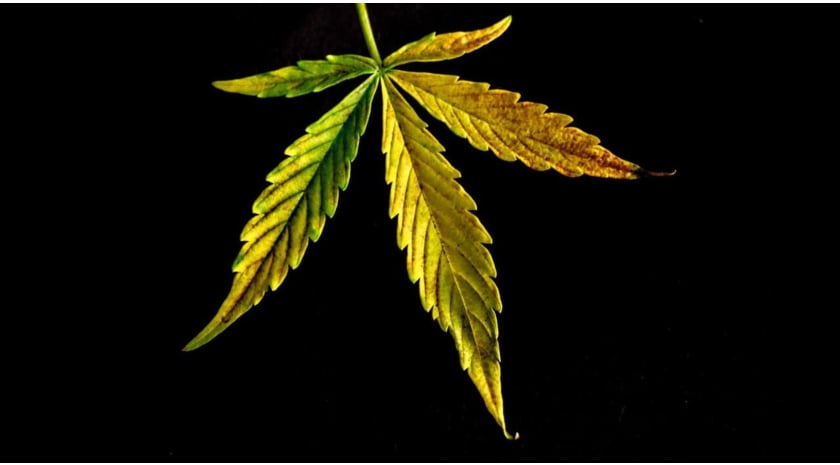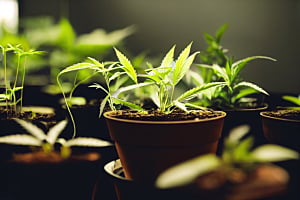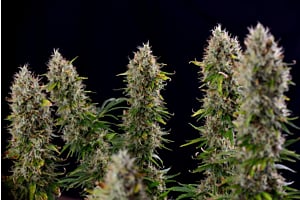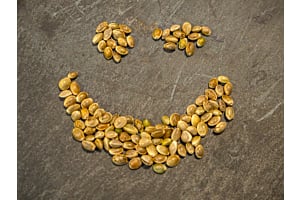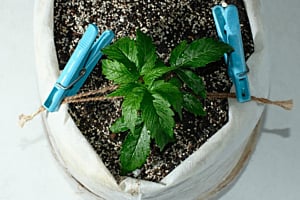Cannabis leaves turning yellow can throw any cultivator off-balance. Weed’s supposed to stay green or turn blue, pink, or purple—not a pale lemony shade! Why does the change of tone happen, and what can you do to solve it?
The discoloration is marijuana’s way of letting you know something’s wrong. Unfortunately, the plant employs yellowing as a universal sign of distress. It takes some know-how to diagnose the issue and determine a proactive course of action. Read on for a systematic overview of this symptom and its meanings. We discuss why cannabis leaves turn yellow and ways to restore their healthy green shade.
Diagnosing yellow leaves on cannabis
There’s no single reason for yellow leaves on cannabis. Numerous diseases can cause it, so start by narrowing down the scope of its potential origins.
Inspect the location of the symptom and the life stage when it occurs—both provide valuable diagnostic data. First up, is your weed plant turning yellow on top? Or is the bottom part the most affected?
Paling on the lower levels is a good indicator the crop isn’t absorbing enough nutrients, especially nitrogen. In this case, discoloration starts at the tips and moves across the blade and onto the stem.
If the yellow weed leaves mainly sit on the uppermost or outer layers, it’s likely environmental trouble. Light, heat, and infections attack what they can reach, which is the sides rather than the bushy center and bottom sections of your weed plant.
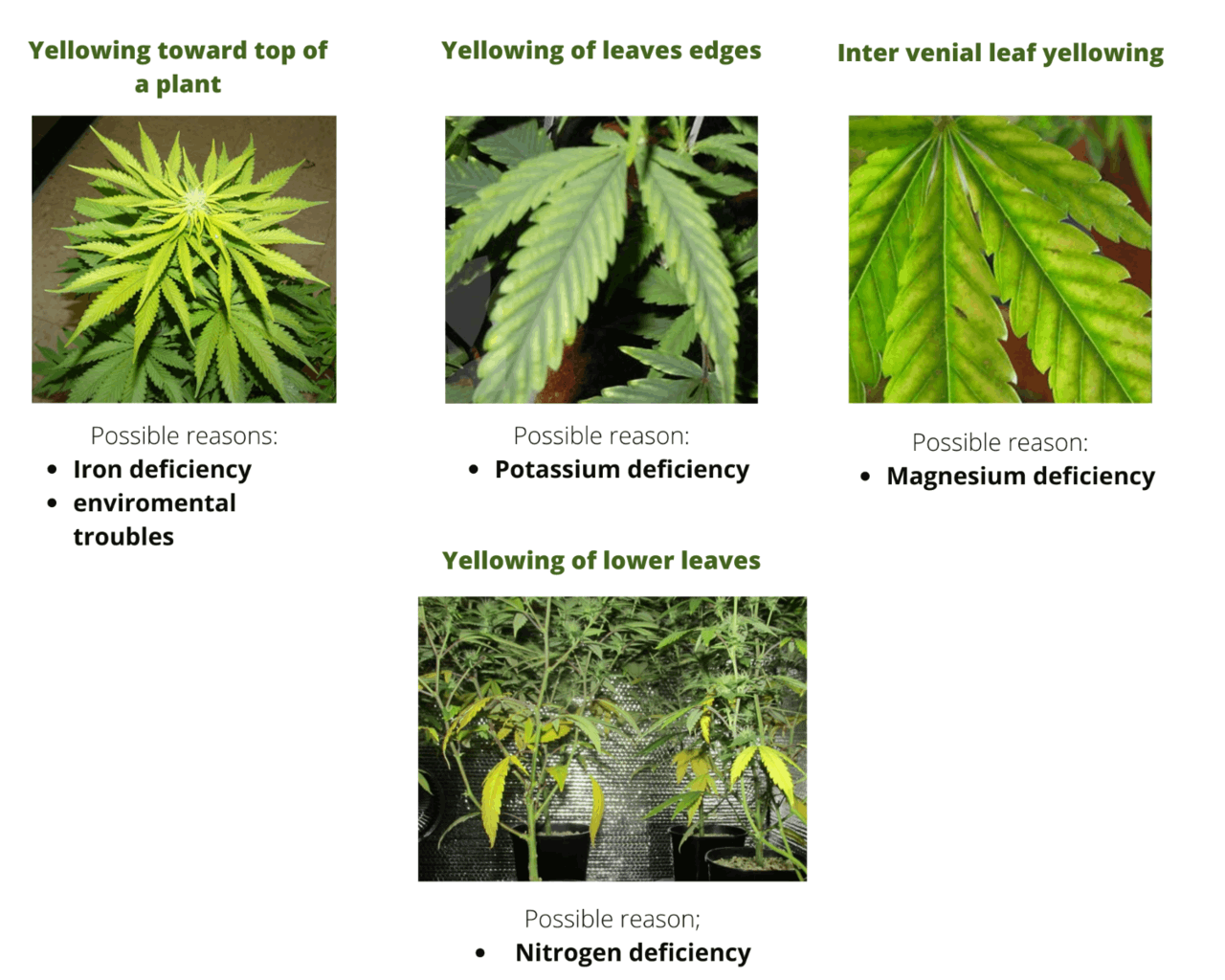
It also matters whether you see cannabis yellow leaves in the seedling, vegetative, or flowering phase. This point relates to deficiencies—marijuana’s nutrient requirements change with the life stage. You’re likely to face a nitrogen scarcity in vegging, while flowering brings troubles with potassium, magnesium, and calcium.
Seedlings aren’t prone to nutrient scarcities but are extra vulnerable to external stress. They need hot, moist environments with plenty of light, so yellow cotyledons indicate inadequate light exposure and watering habits. What’s more, younger plants are susceptible to light and heat burn. Flowering crops are attractive to pests and infections.
Once you have these points in mind, it’s easier to determine why there are yellowing leaves on the weed. Let’s explore the potential culprits.
Common reasons for yellow weed leaves
The hardest part of fixing discoloration is setting an accurate diagnosis. This distress cue points to various health issues, calling for some detective work on your part. Here are the reasons why cannabis leaves turn yellow, related symptoms, and actionable solutions.
Improper watering
Weed only thrives in an effective wet-dry cycle. It requires the right amount of aqua at regular intervals to develop a sturdy root system.
Overwatered cannabis plants’ root systems drown in the moist medium; underwatered crops are brittle, papery, and slow to develop. Both moisture extremes can lead to marijuana leaves turning yellow by deeming the plant incapable of intaking nutrients. Besides discoloration, overdoing it with moisture brings the following symptoms:
- Heavy, drooping canopy
- Thick leaves curling down
- Discoloration of the stem
Note: Overwatering affects the crop in its entirety. If your yellow marijuana is only displaying distress on the leaf tips, it’s likely a different issue.
On the other hand, underwatering presents the following signs:
- Crispy, light foliage
- Browning leaf edges
- Small new growth
A plant that lacks water is darker and slower to develop. The soil begins to crack and pull from the sides of the pot inward. How to proceed after you notice marijuana leaves turning yellow and conclude your watering practices are awry? The immediate solution is simple—provide more or less moisture. Only soak when the pot is light, and the top of the soil feels dry. Rely on frequency rather than amounts.
You should also check for underlying causes of overwatering and underwatering. Doing so ensures you don’t face the same trouble three weeks later. Poor drainage leads to muddy soil that never completely dries out. Moist earth suffocates the roots and becomes a breeding ground for fungus.
Oversized containers hinder water and nutrient absorption, especially with young crops. Keep your ladies in properly-sized containers and well-aerated substrates to avoid trouble.
pH is too high or too low
The second explanation for cannabis leaves turning yellow is pH. Marijuana can only absorb minerals at a specific pH range and prefers its substrates to be slightly acidic. An imbalance makes it unable to metabolize nutrients, and no food means no life. Cultivators in all environments need to be careful about their medium and maintain:
- 5.5–6.5 in hydro
- 6.7–7.0 in soil
When the water or substrate is too alkaline or acidic, the plant can no longer consume the minerals from its surroundings. The consequence is a nutrient lockout, leading to yellow weed leaves and stunted growth. The specific appearance of a lockout varies from one deficiency to the next, but it usually manifests as:
- Limp and loose foliage
- Burnt leaf tips and edges
- Pale stems and branches
Lockout resembles deficiencies, so check pH before supplying additional food. Grab a pH pen and measure the acidity of:
- Water source
- Nutrient solution
- Runoff on the tray
That way, you can gauge whether the soil, nutrients, or water are causing yellow leaves on cannabis. Flush with pure H2O to restore a pH-neutral environment. Continue feeding and watering regularly, but use a pH-Up or pH-Down solution to balance your sources.
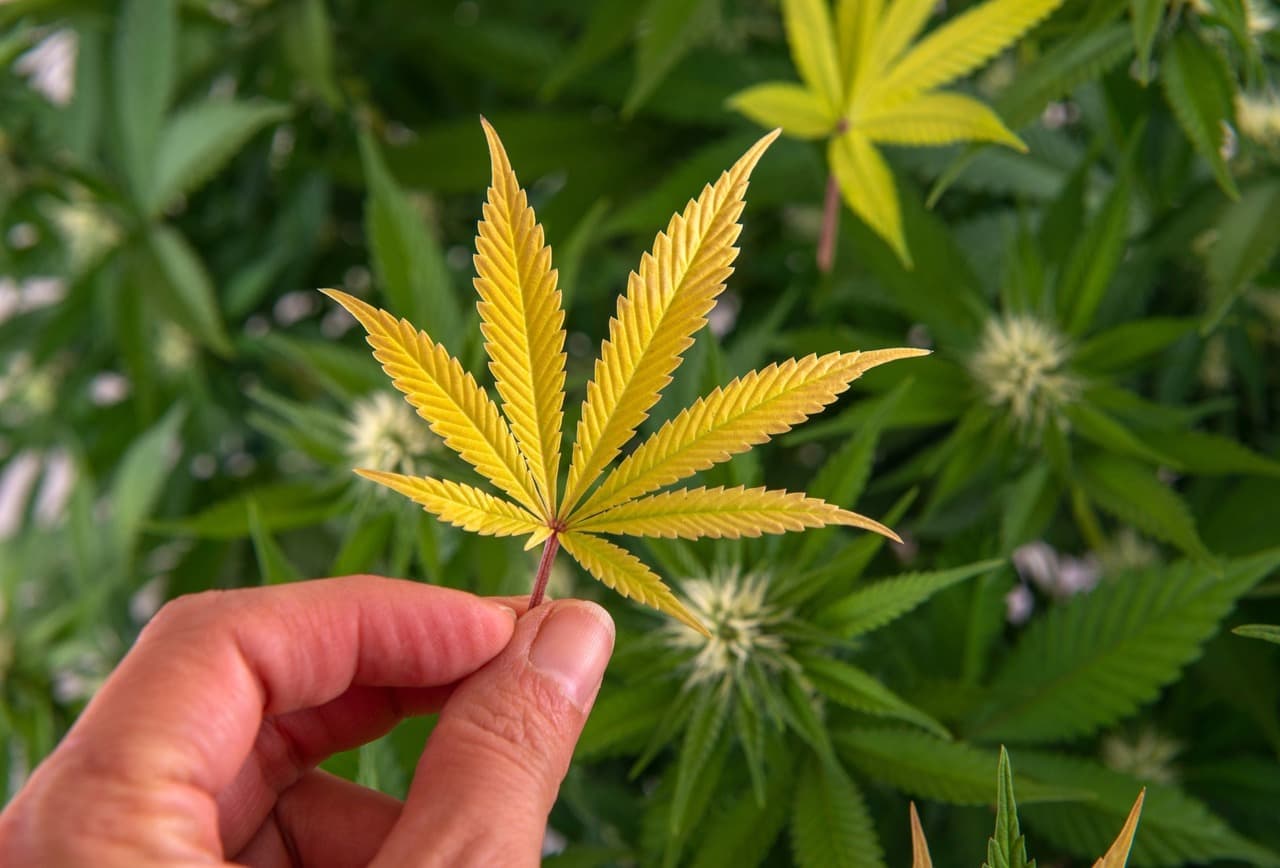
Nutrient deficiency
Young seedlings produce necessary food through photosynthesis, but crops in vegging and flowering need considerable mineral sources to thrive. Deficiencies occur when nutrients are scarce and can prevent vital plant life functions. Several deficiencies cause yellow cannabis. Since there’s not enough food to go around, the canopy grows smaller and paler until it eventually collapses.
Notably, these four minerals are behind the dreaded symptom:
- Calcium deficiency: affects the middle of the leaf, causing brown spots across yellow weed leaves.
- Nitrogen deficiency: affects the bottom fan leaves, making them pale from the tips inward.
- Potassium deficiency: affects the center of all leaves, leading to brown spots and overall loss of chlorophyll.
- Manganese deficiency: affects new growth, causing it to brighten; foliage might disintegrate with time.
If there’s a deficiency causing the yellow weed plant, you should feed more, right?
Yes, but not immediately. You might end up with nutrient burn and waste money on pricey organic nutrients. Instead, start by checking:
- pH levels—lockout is a likely reason for a deficiency
- Water amounts—overwatering and underwatering hinder absorption rates
If both these elements are in order, supplement the nutrient that’s in shortage. Choose balanced soil for weed rich in organic minerals to avoid chemicals messing with the flavor of your future bud.
Too much or too little light
Indoor growers using lamps should be extra careful about positioning. Keeping lights too close to or far from the canopy can make cannabis leaves turn yellow. This problem has nothing to do with heat—it’s the most common with powerful and cool LEDs. When the light’s too scarce, you notice discoloration at the bottom first. Insufficient penetration means the lower sections don’t receive enough illumination for photosynthesis, so they lose chlorophyll.
Overexposure to light is a top-down problem. When lamps sit too near the crop, they affect the top cola and surrounding leaves, which bleach and pale. You might also notice burnt foliage tips. How do you solve this cause of yellow marijuana?
Get a lux meter to measure the light your crops are getting. You can know more from this article on the perfect amount of light a weed plant needs. Both readings should stay within these ranges:
- 30,000–60,000 lumens for vegging
- 45,000–70,000 lumens for flowering
Adjust the distance according to the lamp manufacturer’s instructions. Repeat the test after several hours to see whether the intensity rose or dropped to desirable levels.
Cold or heat stress
Here’s another environmental factor that could induce cannabis leaves yellowing. Marijuana enjoys temperatures in the 68–85°F range. Colder or hotter environments stress the crop; they respond by signaling their suffering. Yellow weed leaves are frequent after overexposure to cold. The canopy might even take on a blue or purple overtone if the temperatures plunge too significantly. Leaves drop off and die after extended periods of temps below 50°F.
Heat stress is harder to pinpoint. It also takes longer to settle in, as many cultivars love tropical environments. If the air is over 85°F for too long, though, you might see:
- Wilting and drooping canopy
- Leaves curling upward and inward
- Bleaching at the uppermost sections
- Brown spotting across the leaves
You don’t have to wait for the full yellow cannabis symptoms to appear before acting—the thermometer can point to a problem. Diligent climate control is the easiest way to prevent heat stress. Remember that temperature doesn’t operate in isolation. Humidity and circulation go a long way in regulating the environment, so keep everything in the correct range.
Tip: Learn the temperature requirements of your choice strain. Shorter and bushier specimens are more sensitive to heat, while tall, skinny ones don’t like the cold. Regularly check the grow room meters to catch stress early.
Bugs and mold
The next cause for discoloration is the animal life looking to munch on marijuana. Many creatures love the herb, enjoying a meal from its roots, buds, and leaves. Their activity taxes crops, and in response, cannabis leaves turn yellow. Since the issue is a universal stress response, various insects could be to blame. These are the most common:
- Aphids—leaves wilt and yellow
- Mealybugs—spots appear across the leaf
- Whiteflies—cannabis leaves yellow and die
- Leaf miners—canopy becomes pale and weak
Tip: A cannabis bug identification guide we mentioned previously allows you to explore all types of flyers and crawlers you might face in your garden.
Mold is another reason for chlorophyll loss. It occurs when there’s a lot of heat, moisture, and organic matter, like around a potted plant. Besides making cannabis leaves yellow, it produces fine specks on stems, making them soft and mushy.
How do you deal with these offenders? Maintain the optimal growing environment—bugs and mold are prolific in hot and humid conditions. Treat your medium with mycorrhizal fungi to kill any crawlers that might damage the roots. Install physical protections and sow companions to shelter your ganja garden.
Leaf septoria
Leaf septoria is a prolific fungal disease that results in cannabis leaves yellowing. The pathogen first presents as black spots on the foliage. As it progresses, it causes browning, yellowing, wilting, and leaf death. Septoria spreads by wind and rain and flourishes at 60–80°F. It accelerates early flowering and can destroy the foliage if left untreated. Consequences include stunted growth and smaller, weaker yields.
How do you deal with this nasty yellow marijuana disease?
Start by removing infected foliage. Clean the scissors after cutting off each to avoid transmitting spores to surrounding areas. Once you have only healthy leaves, spray them with neem oil. This organic substance takes out the traces of the pathogen and prevents future spreads. Clean out the soil base and add a fresh layer of mulch to cover any lingering spores.
Next, tweak the environment to block future septoria. Improve the air circulation, install a dehumidifier, or move containers to higher ground to expose them to more wind.
Root rot
Finally, we have root rot, a microbial condition that attacks the root system. In this case, yellow cannabis leaves point to a reduced nutrient intake. Rot occurs when the growing medium gets too moist and muddy from excessive watering. Such soil becomes a breeding ground for algae, bacteria, and fungi, which corrupt the root system.
The following issues suggest root rot:
- Brown and slimy roots
- A reek around the soil
- Droopy and withered canopy
What do you do about yellow weed leaves and rotten roots? Introduce mycorrhizal fungi to the soil to fight the offending microbial life. Only water the plants when the top soil inch becomes completely dry. These two remedies resolve milder cases. If roots are still smelly and sludgy, transplant your crops into fabric pots for better aeration and drainage. Dust the medium with the beneficial fungi and wait for the infection to clear.
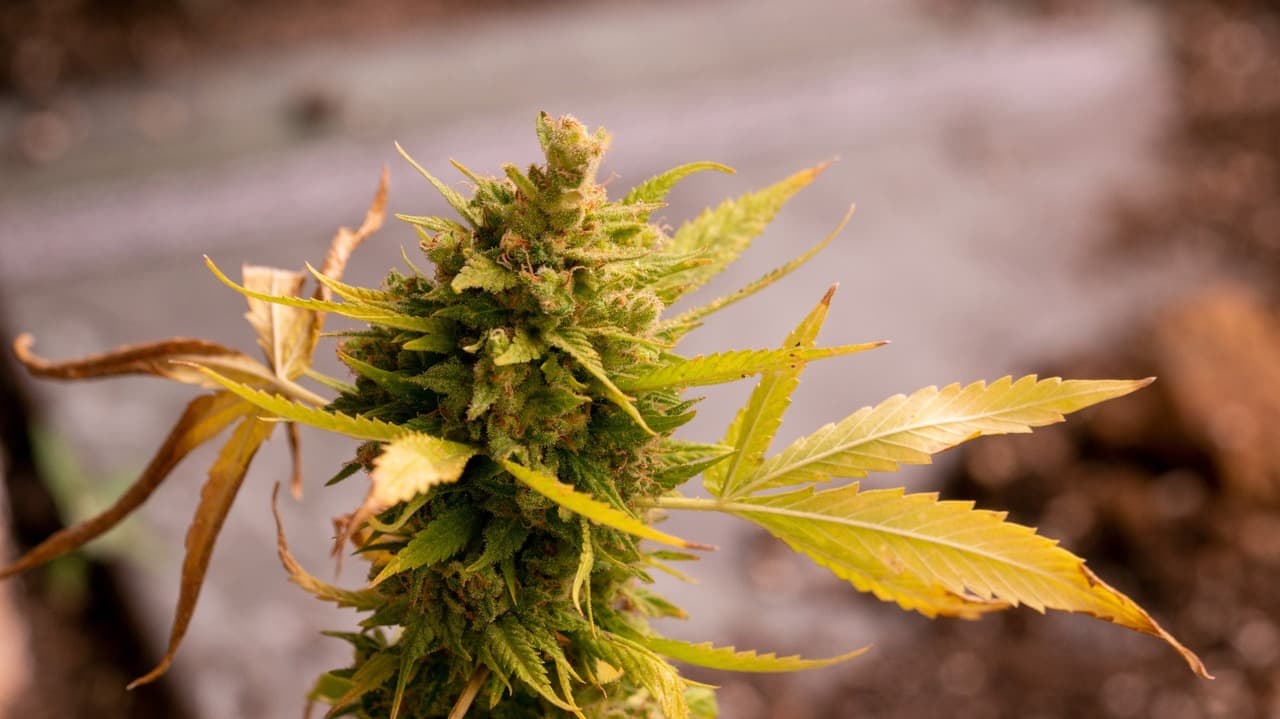
Yellow cannabis: Not the end of the world
Yellow cannabis leaves can be hard to understand, but they’re easy to remedy. Don’t panic after noticing this problem, but approach it systemically. Use our guide and inspect your crop. Start by checking external factors—insects, temperature, humidity, and lights. Then examine your gardening practices to pinpoint what went wrong. Once you do, apply our simple solutions to get your grow op back on track.
Stay tuned to our blog for in-depth guides on ganja cultivation and consumption. Buy cannabis seeds and grow weed at home to put your new knowledge to practice.
Frequently asked questions about yellow cannabis leaves
Are yellow cannabis leaves always a sign of something bad?
Yellow weed leaves often indicate a plant health issue, but that’s not always the case. Two conditions cause discoloration:
- Senescence—deterioration with age, happening at full maturity
- Chlorosis—loss of chlorophyll due to internal or external stressors
The former is no reason to worry. The latter communicates the plant is sickly, and you should address it as soon as possible.
Should I remove yellow leaves from weed plants?
A yellow marijuana canopy no longer performs photosynthesis. Those leaves waste space, so remove them and leave room for healthy growth. Trimming discolored blades can be beneficial for the crop as a whole. It’ll no longer send valuable resources to unproductive areas, directing energy to branch, leaf, and bud production instead.
Why are the lower leaves of my weed plant turning yellow?
The lowest level of fan leaves may lose their brilliance due to nutrient deficiencies or natural aging processes. The first option is concerning. Yellowing around the base follows a nitrogen scarcity. It usually occurs in the vegetative stage and requires immediate action. It’s a different story with yellowing leaves during flowering, especially in the late stages. Discoloration happens naturally before the harvest, as the plant doesn’t need a rich canopy.
Why are my seedlings turned yellow?
Seedlings are fragile and quick to show signs of distress. Young yellow marijuana is often the outcome of poor lighting or watering inadequacies. Cotyledons under inadequate light lose color because they’re incapable of photosynthesis. Excessive moisture drowns the little leaves, and when there’s not enough water, the roots can’t stretch.

 THC
THC THCA Flower
THCA Flower